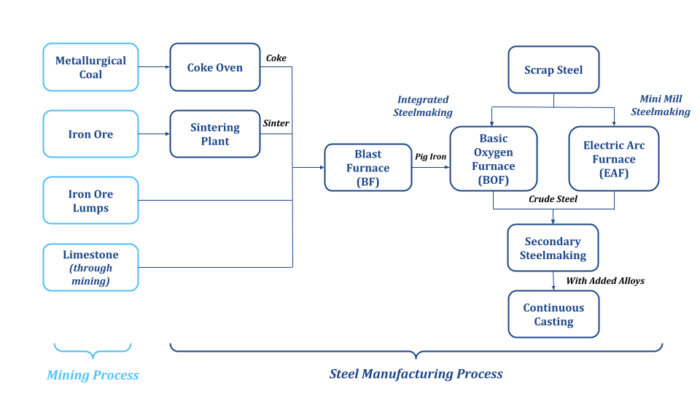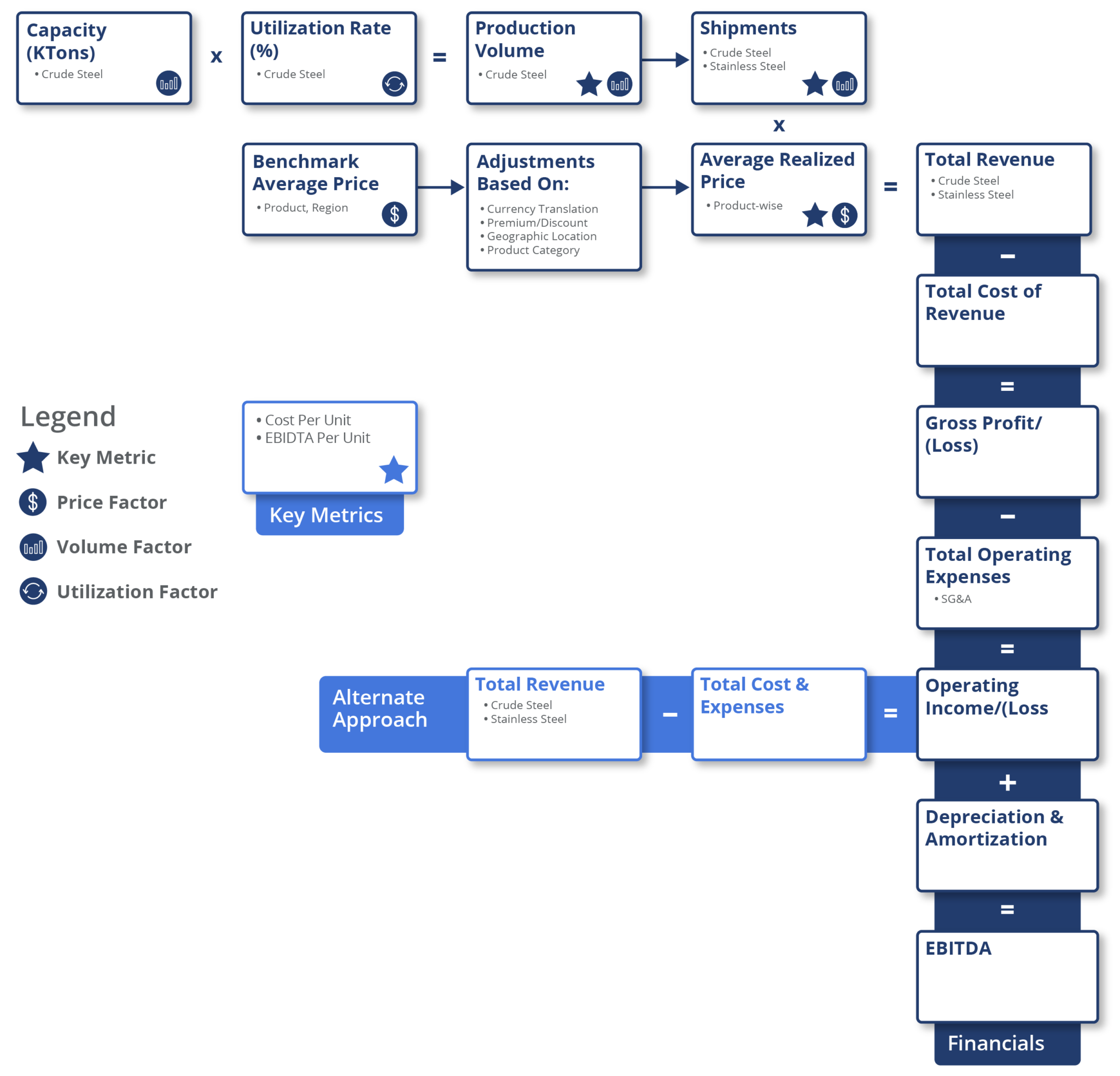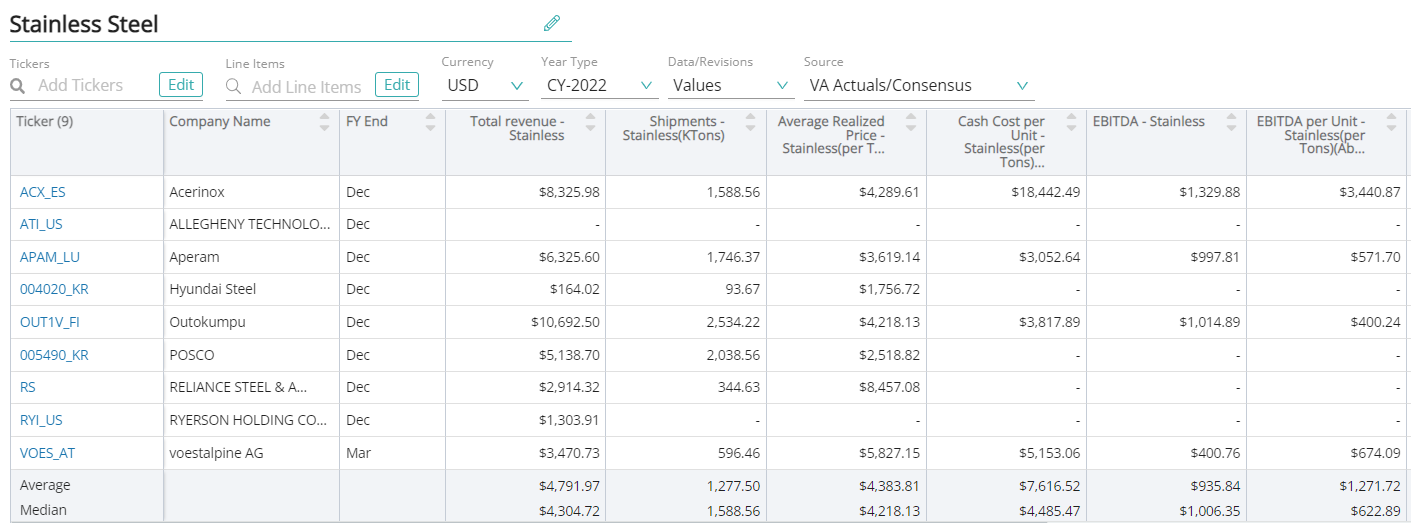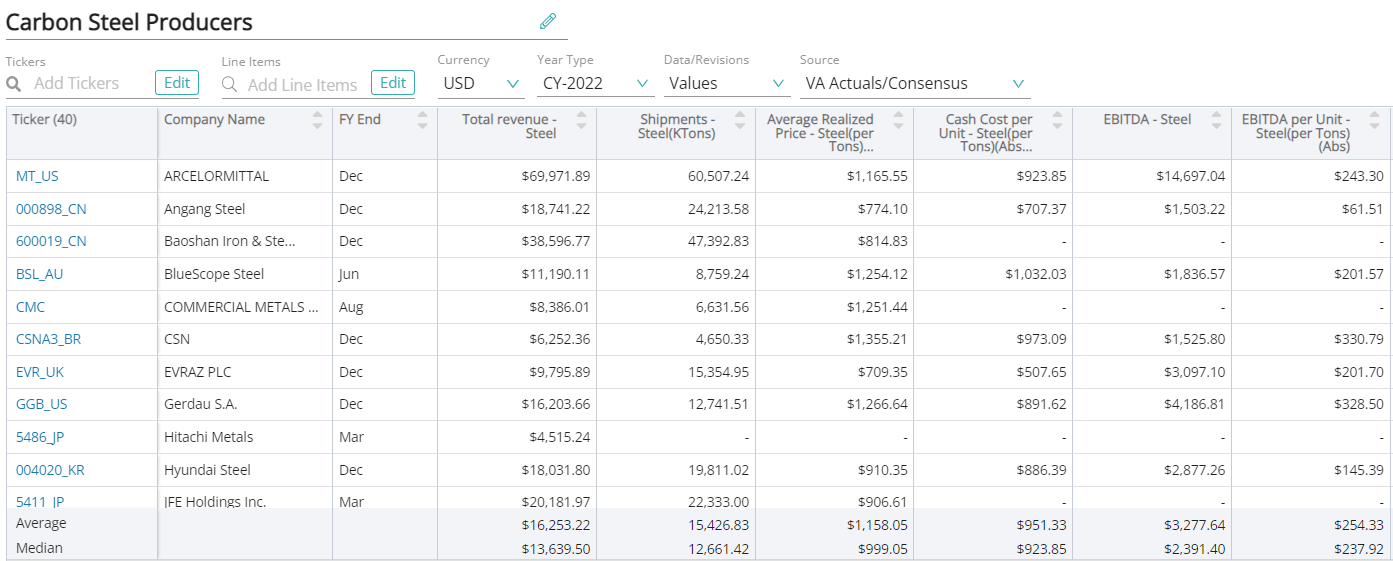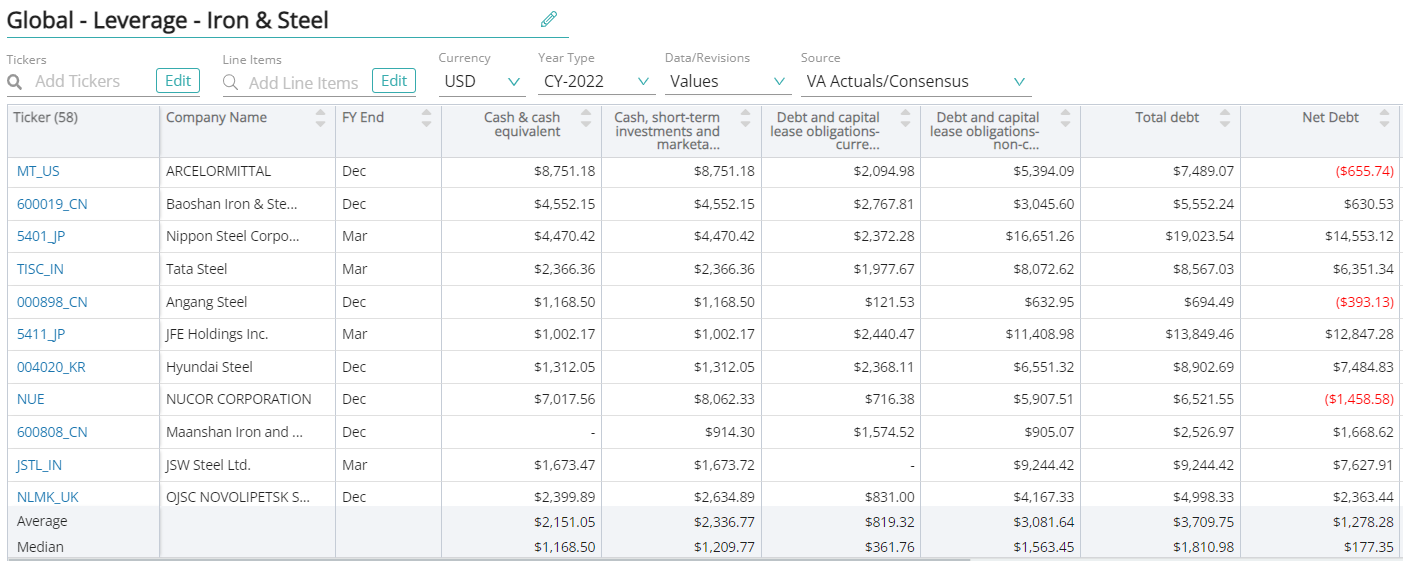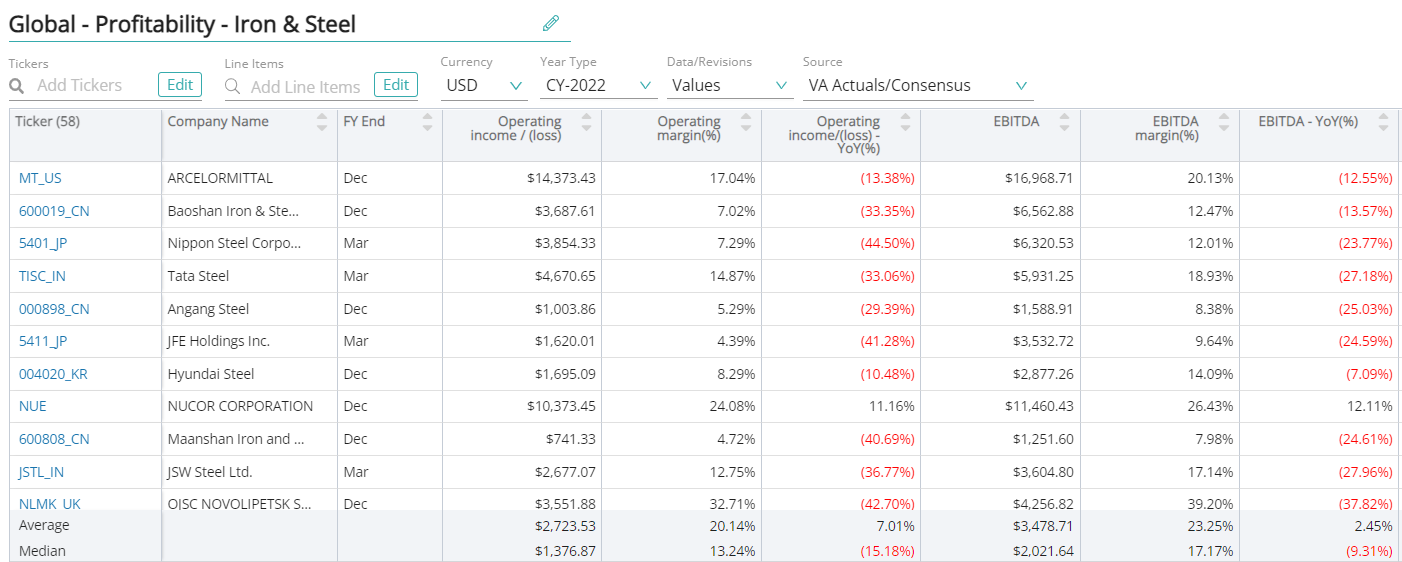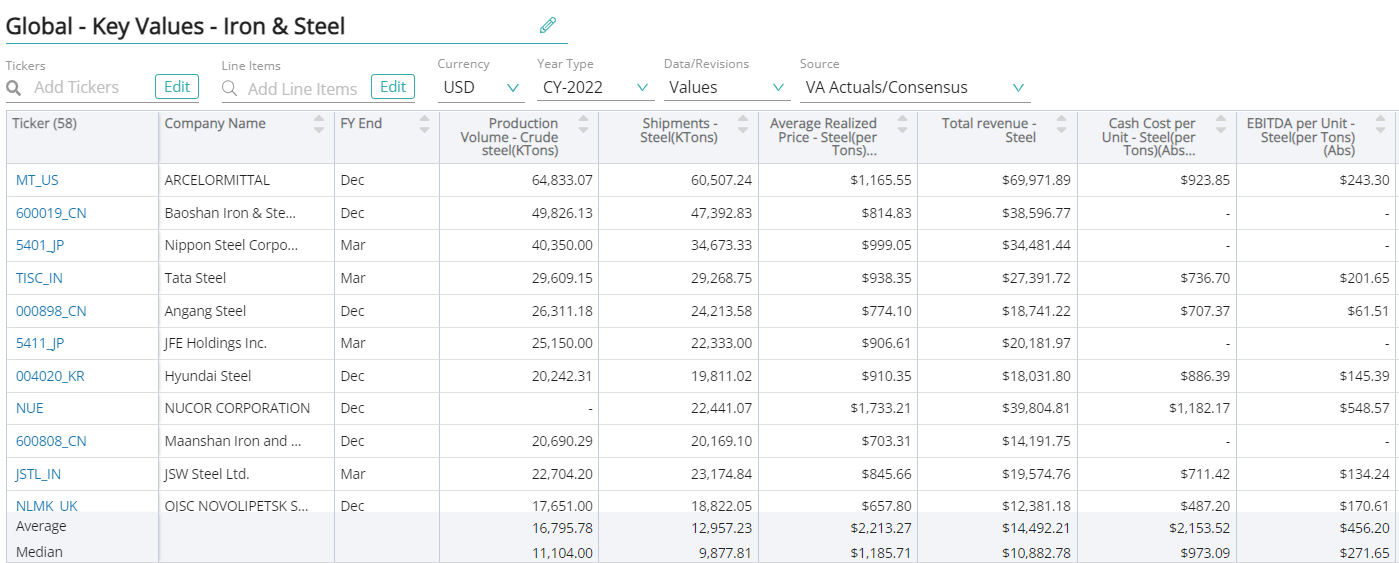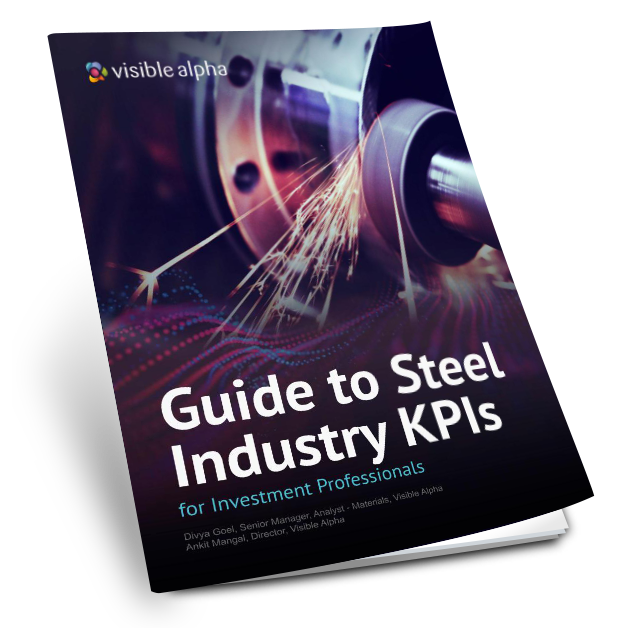Production volume is the total volume of crude steel produced in a given period.
When understanding market expectations for the steel industry, whether at a company or industry level, here are some industry KPIs to consider:
Visible Alpha’s Standardized Industry Metrics
To understand market expectations for the steel industry, a key information source is sell-side analyst estimates and consensus forecast data. The buy-side, sell-side, and public companies leverage this type of data to conduct competitive analysis, a type of analysis conducted by professional analysts that involves comparing standardized metrics of one company with those of similar companies. Because companies report metrics differently – and sometimes report on different metrics altogether – standardizing the key metrics for each company can be a cumbersome process.
Visible Alpha Insights includes analyst data, company data, and industry data at a level of granularity unparalleled in the market. Our industry data – Standardized Industry Metrics – enables market participants to quantify and compare market expectations for companies across 150+ industries.
Data as of January 2023
Steel Industry KPI Terms & Definitions
Visible Alpha offers an innovative, integrated experience through real-time, granular consensus estimates and historical data created directly from the world’s leading equity analysts. Using a subset of the below KPIs, this data can help investors hone in on the key drivers of companies to uncover investment opportunities. Learn More >
Production Volume
Production volume is the total volume of crude steel produced in a given period.
Shipments
Shipment is the total volume of different types of steel sold in a given period.
Average Realized Price
Average realized price is the actual/estimated selling prices of different types of steel.
Cash Cost Per Unit
Cash cost per unit is the cash operating cost excluding depreciation & amortization divided by total steel shipments.
EBITDA Per Unit
EBITDA per unit is earnings before interest, tax, depreciation, and amortization divided by total steel shipments.
Alloying Element
Alloying element is any metallic element added during the melting of steel to increase the corrosion resistance, hardness, and/or strength of the steel. Chromium, nickel, and molybdenum are metals most commonly used as alloying elements in producing stainless steel.
Alloy Steel
Alloy steel is a type of steel alloyed with several elements such as nickel, silicon, chromium, and titanium, among others.
Bars
Bars are long steel products that are rolled from billets. Merchant bars and reinforcing bars (rebars) are two common categories. Merchant bars include rounds, flats, angles, squares, and channels that fabricators use to manufacture a wide variety of products such as furniture, stairs railings, and farm equipment. Rebars are used to strengthen concrete in highways, bridges, and buildings.
Billet
Billet is a semi-finished steel form that is used in long steel products. A billet is different from a slab because of its outer dimensions; billets are normally two to seven inches square, while slabs are 30 to 80 inches wide and two to ten inches thick.
Blast Furnace
Blast furnace is a metallurgical furnace lined with heat-resistant (refractory) bricks, used by integrated steel mills to smelt pig iron from iron ore. The furnace derives its name from the “blast” of hot air and gases forced up through the iron ore, coke, and limestone that load the furnace.
Bloom
Bloom is a form of semi-finished steel. Blooms are the intermediate-stage pieces of steel produced by a first pass of rolling that works the ingots down to a rectangular cross-section that is more than 8”. Blooms are also part of the high-quality bar manufacturing process.
Capacity
Capacity is the general ability of a steel company to produce crude steel in a given period.
Carbon Steel
Carbon steel is a type of steel that has properties made up mostly of the element carbon and which relies on the carbon content for structure. Most of the steel produced in the world is carbon steel.
Coating
Coating is a covering that is applied to the surface of an object, usually referred to as the substrate. The coating may be used for decorative or functional purposes. The process of covering steel with another material (tin, chrome, and zinc), is primarily for corrosion resistance.
Coke
Coke is a processed form of coal. It is the basic fuel consumed in a blast furnace for the smelting of iron.
Crude Steel
Crude steel is a raw form of steel, also known as molten steel or pig iron, which is further processed to make end products.
Electric Arc Furnace (EAF)
Electric arc furnace (EAF) is a steel-making furnace where scrap steel is heated and melted by the heat of electric arcs striking between the graphite electrodes and the metal bath.
Extrusion
Extrusion is the process of shaping material by forcing it to flow through a shaped opening in a die.
Coils
Coils are the most efficient way to store and transport sheet steel.
Galvanized Steel
Galvanized steel is steel coated with a thin layer of zinc to make it corrosion resistant to be used in underbody auto parts, garbage cans, storage tanks, or fencing wire.
Hot-Rolled Steel
Hot-rolled steel is a coil of steel rolled on a hot-strip mill (hot-rolled steel). It can be sold to customers in its original form or further processed into other finished products.
Cold-Rolled Sheet
Cold-rolled steel is sheet steel that has been pickled and runs through a cold-reduction mill. Cold-rolled sheet is considerably thinner and stronger than a hot-rolled sheet and thus sells for a premium.
Long Steel Products
Long steel product is a classification of steel products that includes a bar, rod, and structural products that are ‘long’, rather than ‘flat’.
Pellets
Pellets are iron ore particles, typically rolled into 6-16 mm balls and used as a raw material for blast furnaces. Pellets typically have 64-70% iron content.
Reinforcing Bar (Rebar)
Reinforcing bar (rebar) is commodity-grade steel used to strengthen concrete in highways and building construction.
Scrap Steel
Scrap steel is a ferrous (iron-containing) material that is generally remelted and recast into new steel.
Semi-finished Steel
Semi-finished steel includes steel shapes — such as blooms, billets, or slabs — rolled into finished products such as beams, bars, or sheets.
Slab
Slab is the most common type of semi-finished steel. Traditional slabs measure ten inches thick and 30–85 inches wide and average at about 20 feet long, while the output of the recently developed ‘thin-slab’ casters is approximately two inches thick. After casting, slabs are sent to the hot-strip mills and rolled into coiled sheet and plate products.
Stainless Steel
Stainless steel is the term for grades of steel that contain more than 10% chromium, with or without other alloying elements. Properties of stainless steel include corrosion resistance and the ability to maintain strength at high temperatures.
Specialty Steel
Specialty steel is a category of steel that includes electrical (see silicon electrical steel), alloy (see alloy steel), stainless (see stainless Steel), and tool steel.
Structurals
Structural is a steel product group that includes I-beams, H-beams, wide-flange beams, and sheet pilings. These products are used in the construction of multi-story buildings, industrial buildings, bridge trusses, vertical highway supports, and riverbank reinforcement.
Unit Metrics
- Metric Ton (mt) – A unit of mass and weight equal to 1,000 kilograms, or 2,204.6 pounds.
- Gross Ton: 2,240 pounds.
- Long (Net) Ton: 2,240 pounds.
- Short (Net) Ton: 2,000 pounds. Normal unit of statistical raw material input and steel output in the U.S.
Conversions
- 1 Long Ton = 1.01605 metric ton (mt)
- 1 Short Ton = 0.907185 metric ton (mt)
- 1 Pound = 0.000453592 metric ton (mt)
Download this guide as an ebook today:
Guide to Steel Industry KPIs for Investment Professionals
This guide highlights the key performance indicators for the steel industry and where investors should look to find an investment edge, including:
- Steel Industry Business Model & Diagram
- Key Steel Industry Metrics PLUS Visible Alpha’s Standardized Industry Metrics
- Available Comp Tables
- Industry KPI Terms & Definitions

